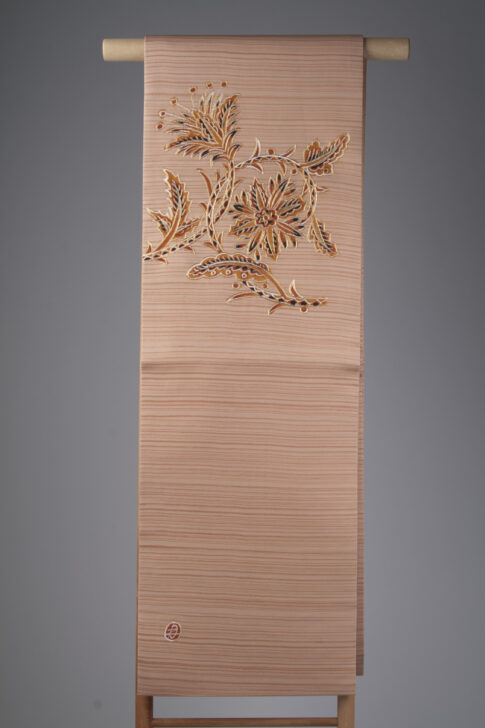Beige Obi with wax-resist overall patterns of rust stripes, interrupted by wax-resist and embroidered designs of floral scrolls
Minagawa Gekka

Description
Minagawa Gekka
Japan, 1892–1987
Kimono
Sho–wa period (1926–89)
Mid 20th century
Crepe silk with colorful wax resist design
and metallic thread embroidery
Gift of Mrs. Kazuko Miyake, 2016/2.66
Obi
Sho–wa period (1926–1989)
Mid 20th century
Plain-weave silk with roketsuzome (wax-resist dyeing)
designs of stripes and floral arabesques, and embroidery
with gold-covered threads
Gift of Howard and Patricia Yamaguchi, 2005/1.325
This kimono and obi were created by Minagawa Gekka, one of
the greatest innovators in modern textile art. Gekka’s work is
characterized by exotic motifs and complex techniques. In the kimono,
he drew a mix of fall and winter flowers in paste and then dyed the
fabric with base colors. Next, he added the crackled-ice pattern using
an age-old wax-resist technique. After the paste was washed away, he
hand painted the flowers in colorful shades: nandin on the left sleeve,
plum, chrysanthemums, thistle, amaranths, camellias and narcissus on
the front and back, and makino (Chloranthus glaber with red berries)
and more camellias on the right sleeve. For the obi he used wax-resist
to create an overall pattern of rust stripes and embroidered floral
scrolls within a limited palette to achieve the rugged feeling of folk
textiles.
The original owners of these kimono were sisters Shizuko Iwata
and Kazuko Miyake. Their mother, Shizuka Iwata, was a pioneering
female executive in early to mid-twentieth-century Tokyo who ran
a successful real estate business. Iwata ordered kimono for her five
daughters and they often wore striking identical Gekka outfits.
(Item shown in image is the obi, displayed alongside the kimono)
2021 Gallery Rotation
Subject Matter:
Scroll of flower and foliage design is traditionally called “hana karakusa” (Chinese plants with flowers) and has numerous variations. Usually, the flowers in this type are not actual plants, so that they appear exotic as in the design of this obi. The wax-resist dying technique used is called roketsuzome.
Physical Description:
The obi is made of plain silk, on which beige and brown stripes are pattern-dyed. Scrolls of exotic flowers and leaves are hand painted with orange and black color, and embroidered with metallic threads. These plant designs are located on two parts of the obi; when wearing, one will appear in front, and other will appear on the back bow. There is a hand-painted artist’s seal of Chinese character “moon” on one end of the obi.
Usage Rights:
If you are interested in using an image for a publication, please visit https://umma.umich.edu/request-image/ for more information and to fill out the online Image Rights and Reproductions Request Form.